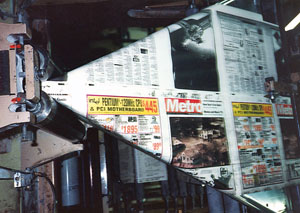“Although it is difficult to comprehend an area as affluent, influential and pervasive as Santa Clara County without a metropolitan newsweekly, the simple fact is that none currently exists. … The often-heard remark about Santa Clara County’s cultural life is ‘What cultural life?’ The cultural ‘problem’ in Santa Clara County isn’t the lack of events, but rather the absence of a print vehicle to recognize and promote its emerging cultural scene.”
—Metro’s 1984 Business Plan
WE’VE ENJOYED a front-row seat at the Digital Media Revolution thanks, paradoxically, to a printed free weekly that began in 1985, the year the Internet was named and The Well online service began.
If technology continues at this clip, Metro will deliver its 50th Anniversary Edition via brainchip, aided by an algorithm that reads thoughts in real time—subject of course to a very stringent privacy policy 😉
Absent the benefit of neural implants, this retrospective was prepared the old-fashioned way, by combing through digital and film-based archives and boxes of yellowed newspapers.
Metro’s quarter-century of reporting on the valley documents its transition from a suburban former fruit-farming area with a semiconductor manufacturing industry into a global producer of consumer goods and online media products—with wealth, political influence, culture and philanthropy.
The Too Much Information Age
Reviewing this body of work affirms the value of publishing and distributing a printed product, as quaint as that seems in 2010. Unlike a Tweet, a Facebook post or a Wikipedia entry, a printed document is a stake in the ground, a body of information that preserves a moment in time.
Unpackaged, we find ourselves swimming in a sea of bits. At 8:15 Tuesday morning, Google News listed 15,847 news articles on a single topic: passage of the Obama health plan. Are we better informed than we once were, now that we’re trying to sip from the Information Firehose?
Without ink, each time we ask the question, the story changes. Search results may vary. History in the information age becomes an endless series of versions, revisions and remixes. Search-engine optimization and digital-identity management influence our views of the world.
All genres and eras of film, music and visual design now coexist simultaneously. Retro is the new now. Indie culture is mass-produced. Mass production is individualized. Design your own shoe, and it will be manufactured in China, with a swoosh on it.
Institutional Accountability
While it’s one thing to put an extra red stripe on a shoe, the mutability of digital culture creates challenges for civic culture. Governments hire webmasters to post their own PR and later remove items from public view. We pay high taxes and permit fees and wonder why library hours are shortened, parks are unmaintained and schools are broke.
It wasn’t always this way.
Twentieth-century journalism developed tools and methodology to probe, investigate, uncover and analyze. It developed a business model to hire people who cultivated sources and developed expertise in subjects. They got out and witnessed history first-hand.
A blogger sitting at home in his or her pajamas doesn’t catch politicians lying about their résumés, their past employment, their investments, their free golf games from lobbyists or their romantic involvements with people they employ with public dollars—all stories that Metro has broken over the years.
Metro was the first to call for a San Jose sunshine ordinance—and participated in its development. San Jose now has some semblance of open government rules, despite a coordinated effort to dilute it by foes of government transparency.
As an early adopter of technology—we started one of the weekly newspaper industry’s first online efforts, Livewire, in 1993—we embrace the new digital world. We’ve built a top 500 Internet company, specializing in local media. And even with the huge choice in information sources, we’re pleased to see that people pick up and read Metro each week around the valley. The free newspaper model has shown resilience, yet there are reasons to be concerned.
San Jose lost its city magazine. Dailies around the Bay Area and community weeklies in the valley have for the most part been consolidated under a single ownership group of mysterious composition. Most of large alternative weeklies in the country have also fallen under a common ownership umbrella. That group, Village Voice Media, was declared in default two weeks ago by the Bank of Montreal after the Bay Guardian secured a $21 million judgment against it because of alleged predatory pricing by the SF Weekly.
Independent and Community-focused
Metro remains one of the few remaining independently owned and operated publications in the valley and in its industry. Our mission will be to remain vital in a world where everyone carries small pocket two-way communication devices that can record and distribute video to the world, tell time, perform calculations, navigate streets, play and identify songs, serve as flashlights or track and graph sleep patterns.
An independent, community-supported press, we believe, is important to the quality of life in our area, and we hope it will continue to be supported as new media continue to encroach. For 25 years, we have partnered with local businesses and groups to bring to life jazz and outdoor music festivals, film festivals, downtown districts and, most recently, Silicon Valley Restaurant Week. We exist in the marketplace, which makes us accountable to the community. New models, such as digital hat-passing to pay for stories or foundation-funded nonprofit publishing, will, we believe, make journalism more susceptible to agendas and interest groups.
After publishing 1,300 issues here, we’re proud to have been a part of Silicon Valley’s evolution and will do our best to continue to keep our coverage scrappy, honest and community focused.
1985
1986
1987
1988
1989
1990
1991
1992
1993
1994
1995
1996
1997
1998
1999
2000
2001
2002
2003
2004
2005
2006
2007
2008
2009




